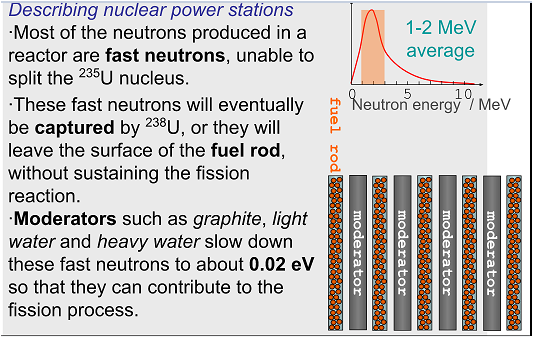IB PHYSICS HL(Higher level) – 2024 – Practice Questions- All Topics
Topic 8.1 Energy sources
Topic 8 Weightage : 3 %
All Questions for Topic 8.1 – Specific energy and energy density of fuel sources , Sankey diagrams , Primary energy sources , Electricity as a secondary and versatile form of energy , Renewable and non-renewable energy sources
Question
Which change produces the largest percentage increase in the maximum theoretical power output of a wind turbine?
A Doubling the area of the blades
B Doubling the density of the fluid
C Doubling the radius of the blades
D Doubling the speed of the fluid
▶️Answer/Explanation
Ans: D
Power Delivered by Wind Generator:

Assume a rotor blade radius of r. ∙
The volume of air that moves through the blades in a time t is given by
V = Ad = Avt, where v is the speed of the air and A = πr2.
The mass m is thus m = ρV = ρAvt.
EK = (1/2)mv2 = (1/2)ρAvtv2 = (1/2)ρAv3t.
Power is \(\frac{E_K}{t}\) so that
\(\frac{E_K}{t}=\frac{1}{2} A\rho v^3\)
Where \(A = \pi r^2\)
Question
Burning one litre of gasoline produces more energy than burning one kilogram of coal, and the density of gasoline is smaller than 1 g  . What can be deduced from this information?
. What can be deduced from this information?
A Energy density is greater for gasoline.
B Specific energy is greater for gasoline.
C Energy density is greater for coal.
D Specific energy is greater for coal.
▶️Answer/Explanation
Ans: B
Specific energy ESP is how much energy (J) you can get per unit mass (kg) from a fuel. Its units are J kg-1.
Energy density ED is how much energy (J) you can get per unit volume (m3). Its units are J m-3.
\(\text{Mass of gasoline burnt } = \text{density}\times \text{volume}\)
or
\(\text{Mass of gasoline burnt } = \frac{\text{1 g}}{cm^3} \times 1000 \; cm^3\)
\(\text{Mass of gasoline burnt } = 1\;kg\)
Mass of fuels is given , hence specific energy need to be compared
now energy produced by Gasoline \(= (E_{sp})_{gasoline}\times mass\)
\(=(E_{sp})_{gasoline}\times 1 kg\)
energy produced by coal \(= (E_{sp})_{coal}\times mass\)
\(=(E_{sp})_{coal}\times 1kg\)
Since (given in question)
energy produced by Gasoline > energy produced by coal
Hence
\((E_{sp})_{gasoline}\times 1 kg >(E_{sp})_{coal}\times 1kg\)
or
\((E_{sp})_{gasoline} >(E_{sp})_{coal}\)
Question
What part of a nuclear power station is principally responsible for increasing the chance that a neutron will cause fission?
A. Moderator
B. Control rod
C. Pressure vessel
D. Heat exchanger
▶️Answer/Explanation
Markscheme
A

Question
The Sankey diagram shows the energy input from fuel that is eventually converted to useful domestic energy in the form of light in a filament lamp.

What is true for this Sankey diagram?
A. The overall efficiency of the process is 10%.
B. Generation and transmission losses account for 55% of the energy input.
C. Useful energy accounts for half of the transmission losses.
D. The energy loss in the power station equals the energy that leaves it.
▶️Answer/Explanation
Markscheme
A
The efficiency of a conversion is given by
\(Efficiency =\frac{output}{Input}\)
Given in the Sanky diagram

Hence
\(Efficiency =\frac{output}{Input}\)
Putting given values
\(Efficiency =\frac{2}{20} =0.1 =10%\)
Question
In a hydroelectric power plant, water of density 103 kg m–3 falls through an average height of 100 m. The volume of water flowing through the pipes per second is 10 m3 s–1. What is the maximum power generated?
A. 104W
B. 105W
C. 106W
D. 107W
▶️Answer/Explanation
Markscheme
D
Power = Energy flow per second
Now average height of pipe = 100 m , acceleration due to gravity g = 10 \(ms^{-2}\)
Mass of water flowing per second = \(\rho \times v =10^3 \times 10 =10^4 \)
Potential energy reservoir relinquishes each second \(= mgh = 10^4 \times 10 \times 100 =10^7 \)
This is same as power = \(10^7 W\)
Question
In the production of electric power, an advantage of using photovoltaic cells rather than fossil fuels is that the photovoltaic cells
A. can be effective in any location.
B. can be used continuously.
C. have low initial set-up costs.
D. are more environmentally friendly when in use.
▶️Answer/Explanation
Markscheme
D
The photovoltaic cell converts sunlight directly into electricity.
The cell is made of crystalline silicon (a semiconductor) doped with phosphorus and boron impurities.
Electricity produced by solar cells is clean and silent. Because they do not use fuel other than sunshine, PV systems do not release any harmful air or water pollution into the environment, deplete natural resources, or endanger animal or human health. Photovoltaic systems are quiet and visually unobtrusive
